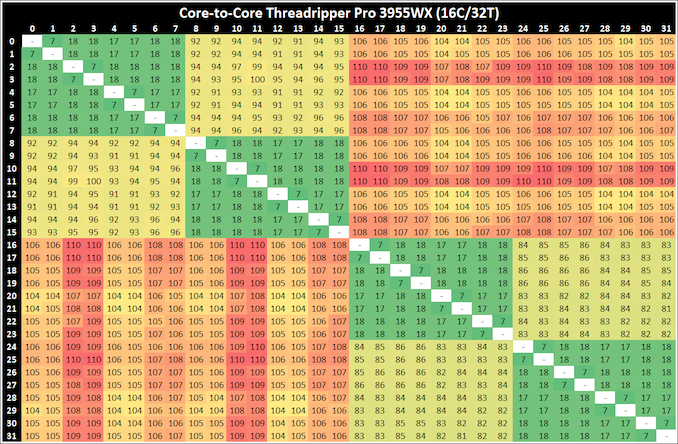AMD Threadripper Pro Review: An Upgrade Over Regular Threadripper?
by Dr. Ian Cutress on July 14, 2021 9:00 AM EST- Posted in
- CPUs
- AMD
- ThreadRipper
- Threadripper Pro
- 3995WX
CPU Tests: Microbenchmarks
Core-to-Core Latency
As the core count of modern CPUs is growing, we are reaching a time when the time to access each core from a different core is no longer a constant. Even before the advent of heterogeneous SoC designs, processors built on large rings or meshes can have different latencies to access the nearest core compared to the furthest core. This rings true especially in multi-socket server environments.
But modern CPUs, even desktop and consumer CPUs, can have variable access latency to get to another core. For example, in the first generation Threadripper CPUs, we had four chips on the package, each with 8 threads, and each with a different core-to-core latency depending on if it was on-die or off-die. This gets more complex with products like Lakefield, which has two different communication buses depending on which core is talking to which.
If you are a regular reader of AnandTech’s CPU reviews, you will recognize our Core-to-Core latency test. It’s a great way to show exactly how groups of cores are laid out on the silicon. This is a custom in-house test built by Andrei, and we know there are competing tests out there, but we feel ours is the most accurate to how quick an access between two cores can happen.
On all our Threadripper Pro CPUs, we saw:
- a thread-to-thread latency of 7ns,
- a core-to-core in the same CCX latency as 17-18 nanoseconds,
- a core-to-core in a different CCX scale from 80 ns with no IO die hops to 113 with 3 IO die hops
Here we can distinuguish how long it takes for threads to ping back and forth with cores that are different hops across the IO die.
A y-Cruncher Sprint
The y-cruncher website has a large about of benchmark data showing how different CPUs perform to calculate specific values of pi. Below these there are a few CPUs where it shows the time to compute moving from 25 million digits to 50 million, 100 million, 250 million, and all the way up to 10 billion, to showcase how the performance scales with digits (assuming everything is in memory). This range of results, from 25 million to 250 billion, is something I’ve dubbed a ‘sprint’.
I have written some code in order to perform a sprint on every CPU we test. It detects the DRAM, works out the biggest value that can be calculated with that amount of memory, and works up from 25 million digits. For the tests that go up to the ~25 billion digits, it only adds an extra 15 minutes to the suite for an 8-core Ryzen CPU.
With this test, we can see the effect of increasing memory requirements on the workload and the scaling factor for a workload such as this. We're plotting milllions of digits calculated per second.
The 64C/64T processor obtains the peak efficiency here, although as more digits are calculated, the memory requirements come into play.













98 Comments
View All Comments
Threska - Friday, July 16, 2021 - link
One could have more than one.https://www.reddit.com/r/hardware/comments/mc8j2c/...
Especially depending upon the memory type.
https://semiengineering.com/what-designers-need-to...
croc - Monday, July 19, 2021 - link
The first year anniversary of the Threadripper Pro! And a timely review to celebrate it! Not the CPU, the release... Because that might be the last Threadripper we see for quite some time....I get the impression that AMD has been in the position of runer up for so long now that they don't know how to capitalize on a lead. Either that or by selling off their fab they have lost touch with how to design for fabrication, which might explain their failure to deliver product at the 7NM node. Unfilled Epycs, no Zen 3 Threadrippers...
mode_13h - Monday, July 19, 2021 - link
What a croc!; )
> that might be the last Threadripper we see for quite some time....
The announcement for Chagall is rumored to be coming in August, with volume shipping in September. Have you heard otherwise?
> by selling off their fab they have lost touch with how to design for fabrication
Huh? Why do you think the issue is design-related?
And if we're contemplating counter-factuals, then let's not lose sight of the fact that GF is still on 12 nm. And if AMD still owned them, we should also consider whether the whole enterprise would still be doing business, at all.
> which might explain their failure to deliver product at the 7NM node.
Or maybe they're in the same boat as everyone else, facing higher demand and restricted supply?
croc - Tuesday, July 20, 2021 - link
Lemmee see.... Wasn't Chagall an artist? And wasn't the code name for the Threadripper Zen 3 to be Genesis Peak? And aren't you quoting a rumor? Have there been ANY leaked benchmarks? Has ANY processor EVER launched without leaked benchmarks?The lack of things often speak volumes...
mode_13h - Tuesday, July 20, 2021 - link
> And aren't you quoting a rumor?Yes, that's exactly what I said.
> Have there been ANY leaked benchmarks?
> Has ANY processor EVER launched without leaked benchmarks?
It's a niche product. There typically aren't many motherboard options for them (and even fewer, at launch). I think it's not surprising, if there aren't any benchmark leaks as of yet. There won't be many engineering samples floating around.
Anyway, we'll know within about 5 weeks if there's any truth to the rumor.
croc - Wednesday, July 21, 2021 - link
I will know when a bios with AGESA support for a Zen 3 Threadripper arrives. None have arrived yet, and typically they do so about a month prior. Chagal is an artist, and artist names are usually reserved for apus. Supposedly the next TR will use the TRX40 socket, which means that there are many MBs for testing / leaking. Given that the Epyc still uses the SP3 socket, I believe this to be tue The latest 'chagall' rumor is that it won't release before Sept, mebbe as late as November. Gotta love them movable goal postsPersonaly, I don't think that AMD can get the cores to deliver at the frequencies required for an HEDT product Hell, given their back orders for their server chip I doubt that they even care. Bigger fish to fry, all that. Still, a bit of egg-on-face for Dr. Su. And niche? don't tell the CGI world that they are niche...
Qasar - Wednesday, July 21, 2021 - link
sorry croc, but you could be wrong, looks like TR based on zen 3 could be Chagall, and on both STRX4 and SWRX8, at least according to here :https://www.guru3d.com/news-story/amd-threadripper...
https://www.notebookcheck.net/Zen-3-based-Ryzen-Th...
from moores law is dead, a video about TR zen 3 :
https://www.youtube.com/watch?v=la-7Q_VsWUM
but no concrete info as of yet, but a search on google for threadripper zen 3, all seems to say the same, code name chagall
croc - Saturday, July 24, 2021 - link
No new BIOS since April... 7 days to August, so looks like another no-show, eh...Qasar - Saturday, July 24, 2021 - link
and the point is ? considering their has been no official announcement from amd when zen 3 TR is to be released, why would there be a bios for it yet ?the point of my reply was that you could be wrong on the code name, not the release date.
at least amd HAS a HEDT cpu, when was the last one from intel ?
bottom line : all there are, are rumors, which should be taken with some salt.
croc - Monday, July 26, 2021 - link
That would be the Xeon w-3175x